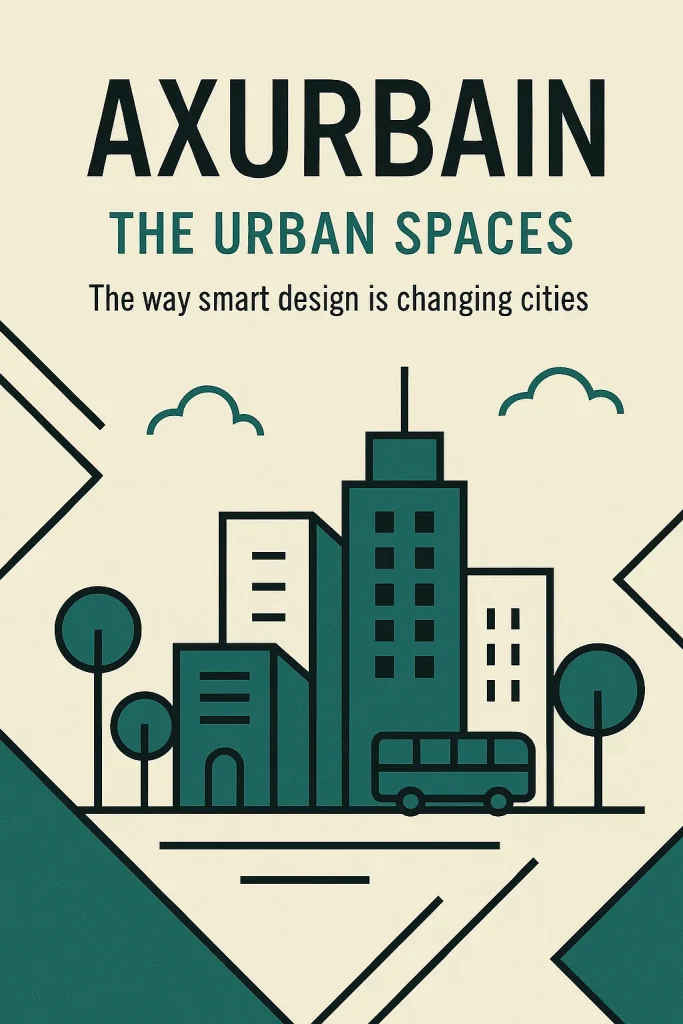Axurbain: The Urban Spaces The way Smart Design is changing cities

Axurbain Introduction
Cities are expanding at an unprecedented rate and with this growth come new victims. When it comes to pollution and traffic, the absence of green spaces, traditional city planning does little to help people by developing spaces in the city that are actually useful. That is where the Axurbain comes in.
Axurbain is the progressive vision of urban development. It combines intelligent design, technology and sustainability to provide a place where communities can live. It does not look at cities as structures and streets, but sees the territory as a living organism, a place that respects people, nature and creation.
We will discuss how Axurbain is transforming cities, its significance, and the future of urban living in this blog.
What is Axurbain and Why It Matters
At its simplest, Axurbain is a concept regarding creating smart and sustainable urban spaces. It is more than a mere urban planning, it is more about the connections that people have with their surroundings on a daily basis.
Human friendly: Streets and buildings are architecturally planned with human beings and communities.
Green: Green roofs will be environmentally friendly, and so will solar lamps and water recycling.
Technology-Driven: Digital solutions and data drive cities to operate in a more efficient way.
Why does this matter?
Since cities shape our living, working and socializing. The poorly planned districts can be a source of stress, pollution and injustice. On the contrary, the intelligent design of Axurbain makes people live healthier, safer and enjoy their life.
Smart Design in Action: Practice
Smart design is not a concept, it is already being implemented in other cities in various parts of the world. Here are a few cool examples:
Bosco Verticale in Milan: You can think of very high contemporary apartment structures that are full of trees and plants. These vertical forests have the positive effect that they clean the air and give birds and insects a home.
Small back streets in Melbourne are called Laneways, which were very boring and empty some years ago, nowadays they are full of art, cafes and shops.
Gardens by the bay Singapore: Supertrees are enormous trees that are elevated to the sky. They are not only beautiful, but they generate solar power, collect rain, and provide amazing green areas where all can have a rest.
The major advantages of Smart Urban Design
When cities embrace ideas such as Axurbain, much more will be achieved other than beauty.
Environmental Sustainability
Carbon footprints are reduced by transport, green rooftop and energy efficient buildings.
Most importantly, Accessibility and Inclusivity
Communities can also reach the disabled through places that they can walk and use public transport.
Community Engagement
Parks, open spaces and common spaces unite people and provide them with stronger social connections.
Safety and Security
The neighbourhoods are healthier with intelligent lighting, open streets and electronic surveillance.
Economic Growth
The beautiful and easily available cities attract new enterprises, tourism and investments and many more.
Put simply, smart design creates better, healthier and happier communities.
Difficulties Cities are experiencing with Implementation
As exciting as the prospects of Axurbain are, the process of actualizing these concepts is not entirely smooth.
Funding Problems: There is a problem of funding in many cities where they find it difficult to set funds aside to carry out a big project.
Regulatory Burdens: Zoning: The presence of old regulations and/or zoning regulations could affect development.
Community Buy-In: It is not easy to listen to the various views when designing with people and this is why it is called Community Buy-In.
Striking the right balance between Sustainability and Aesthetics: To design a green structure that is also beautiful, one has to plan.
Technology Gaps: All city planners do not have the skill required to integrate hi-tech.
Regardless of these challenges, increasing numbers of cities are seeking solutions to address them due to the long term payoffs of smart design outweighing the challenges.
How Technology is Making Cities Smarter
Axurbain is technology driven. Contemporary urban design could not exist without it. This is the way it drives change:
Data Analytics: Helps planners understand how people travel, use energy and needs of the community.
Smart Materials: Self-healing concrete is one of the technologies that allow extension of infrastructure lifespan.
IoT Connectivity: The gadgets that develop traffic, waste, and energy management choices in real-time are sensors and smart lights.
Mobile Apps: allow residents to receive real-time updates on transport, local events and city services.
Axurbain is using technology and creativity to make cities feel more alive, efficient, and responsive.
Case Study: New York high line.
The High Line in New York City can be termed as one of the most popular examples of smart design. It used to be an abandoned elevated railway, and was reconceived as a public park.
community involvement ;The reason is the members of the community took part in the process and hence the space would meet the needs of reality.
Green Integration: Native vegetation is a way of bringing nature to Manhattan.
Social Connection: The occupied spaces and the vacant spaces are socializing.
Economic Boost: This is increased business within the locality in terms of improved foot traffic and tourism.
The High Line is an example that good design not only restores areas but also supports the ethos and prosperity of the community.
Life in the Future with Axurbain
Moving forward, Axurbain provides a path map on how cities will develop. Such developments could be in the future:Additional AI-based products to propose designs and control resources.Combine with popular design and planning systems.Mobile-first solutions to provide real-time access to city services to the citizens.Green policies that promote the use of green technology in all places.
It seeks to make cities healthier, more sustainable and more connected than ever before. Axurbain will be at the center of the urban transformation movement as more communities implement such concepts.
FAQs About Axurbain
Why isn’t Axurbain not like traditional city planning?
Contrary to conventional planning, Axurbain presents a technological, sustainable and design solution to construct people-centered spaces, which are flexible in accordance with the demands of the community.
Can smaller cities embrace the concepts of Axurbain?
Yes! Smart space and green space can be incorporated into even small towns to enhance the quality of life.
How does smart design impact the environment?
Intelligent design will result in a drastic decrease of carbon emissions due to the low level of energy usage, expansion of green territories, and encouragement of green transportation.
Is it only high-tech cities that are using Axurbain?
No. Technology is just part of the role, and Axurbain can be expanded to any size, with creativity and communal needs as its priorities.
What is the greatest difficulty with implementing Axurbain?
After all, funding and regulations tend to cause delays, yet the increased societal interest in sustainable spaces is compelling governments to move at increased speed.
In conclusion: Better Cities with Axurbain
Cities are not the location, but the center of culture, economy and community. Urban areas can be converted into ecosystems that combine technology, sustainability, and human requirements with the principles of Axurbain.
With the High Line of New York to the vertical gardens of Milan, the world already witnessed how city life can be re-invented with the help of smart design. Things are only going to get better as Axurbain keeps motivating more projects across the globe.
When cities move in this direction, they will be able to create healthier, greener, and more interconnected spaces that enable people and nature to be partners. Axurbain is not a theory—it is a call to action to all cities willing to move into the future.






